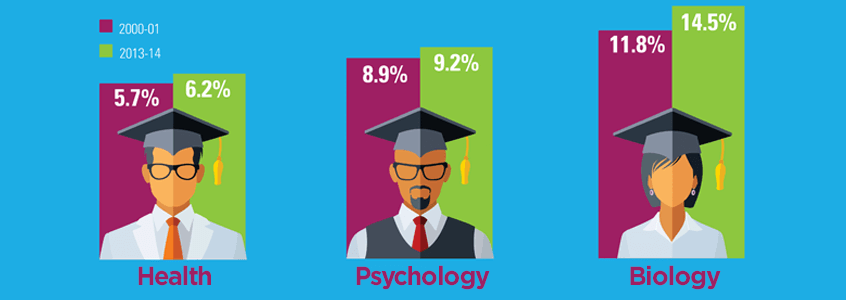
by NSC Research Center | Oct 23, 2024 | 2024, Enrollment Trends, National
In the aftermath of the COVID-19 pandemic, colleges and universities are pressed to re-evaluate their long- and short-term strategies, particularly as they pertain to enrollment management and student support services. The Research Center’s Stay Informed report series continues to enable educational and policy leaders to make informed decisions through timely enrollment trend reporting that began with the pandemic.

by NSC Research Center | Aug 25, 2016 | 2016, Enrollment Trends, National, Postsecondary, Snapshot Report
During the Great Recession, there was a slight increase in the percentage of bachelor’s degree earners who opted to continue their educations at two-year institutions. However, that percentage has now dropped well below pre-recession levels, with only 5.8 percent of 2013-14 bachelor’s degree earners having returned to college at two-year institutions.

by NSC Research Center | Mar 24, 2015 | 2015, Enrollment Trends, National, Postsecondary, Snapshot Report
Nationally, 14.6 percent of all 2013-14 college graduates attended college in at least one other state or territory in the 10 years prior to receiving a credential.

by NSC Research Center | May 5, 2014 | 2014, Enrollment Trends, National, Postsecondary, Snapshot Report
Just over 9% of all students attended more than one institution during the 2012-13 academic year. Overall, student mobility rates increased from 2010-11 to 2011-12, and then stabilized in 2012-13.
by NSC Research Center | Jun 18, 2013 | 2013, Enrollment Trends, National, Postsecondary, Snapshot Report
6.5% of students who graduated with a bachelor’s degree in 2008-09 enrolled in a two-year institution within the next two academic years, an increase from 5.9 percent of 2004-05 graduates.
by NSC Research Center | Nov 29, 2012 | 2012, Enrollment Trends, National, Postsecondary, Snapshot Report
In academic year 2011-12, nearly a third of the first-time college students in two-year public institutions began college in January or later months.
by NSC Research Center | Sep 6, 2012 | 2012, Enrollment Trends, National, Postsecondary, Snapshot Report
On average, 15.1 percent of all U.S. postsecondary students who received undergraduate degrees in 2010-11 had previously attended college in at least one other state or territory. The National Student Clearinghouse Research Center has identified the percentage of undergraduate degree completers in the 2010-11 academic year who had prior enrollments in at least one other state or territory.
by NSC Research Center | Apr 19, 2012 | 2012, Enrollment Trends, National, Postsecondary, Snapshot Report
According to the National Student Clearinghouse Research Center, on average, 38 percent of all students, undergraduate and graduate, in a fall term are adult learners.
by NSC Research Center | Dec 8, 2011 | 2011, Enrollment Trends, National, Postsecondary, Snapshot Report
According to the National Student Clearinghouse Research Center, 3.2% of all students attended two or more postsecondary institutions concurrently during its one-year study period. Concurrent enrollment in this report occurs when a student’s enrollment at two or more postsecondary institutions overlaps by at least 30 days.




